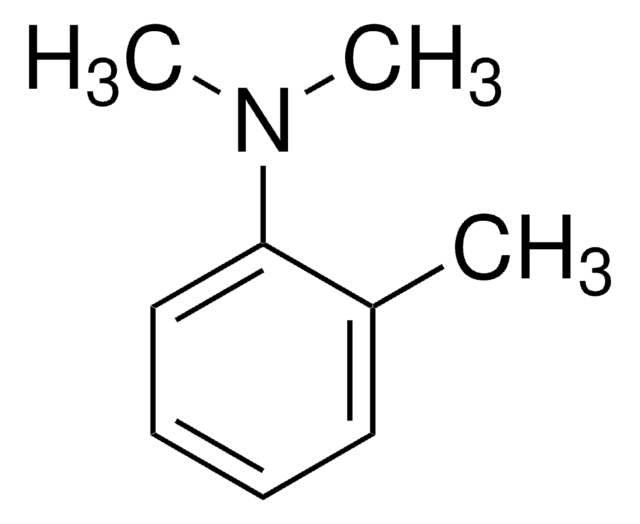41690
4,N,N-Trimethylaniline
catalyst grade (for peroxide polymerization), ≥98.5% (GC)
Synonym(s):
4-Dimethylaminotoluene, N,N-Dimethyl-p-toluidine
About This Item
Recommended Products
grade
catalyst grade (for peroxide polymerization)
vapor density
>1 (vs air)
Assay
≥98.5% (GC)
form
liquid
expl. lim.
7 %
refractive index
n20/D 1.546 (lit.)
n20/D 1.547
bp
211 °C (lit.)
90-92 °C/10 mmHg (lit.)
density
0.936 g/mL at 20 °C
0.937 g/mL at 25 °C (lit.)
SMILES string
CN(C)c1ccc(C)cc1
InChI
1S/C9H13N/c1-8-4-6-9(7-5-8)10(2)3/h4-7H,1-3H3
InChI key
GYVGXEWAOAAJEU-UHFFFAOYSA-N
Looking for similar products? Visit Product Comparison Guide
Related Categories
General description
Application
- Charge-transfer complexes for redox polymerization: 4,N,N-Trimethylaniline used for on-demand amine/peroxide redox polymerization. This research offers a new perspective on the use of 4,N,N-Trimethylaniline in creating controlled polymer structures, which is crucial for various industrial and pharmaceutical applications (Garra et al., 2018).
Caution
Signal Word
Danger
Hazard Statements
Precautionary Statements
Hazard Classifications
Acute Tox. 2 Inhalation - Acute Tox. 3 Dermal - Acute Tox. 3 Oral - Aquatic Chronic 3 - Carc. 1B - Repr. 2 - Skin Sens. 1 - STOT RE 2 Oral
Target Organs
Reproductive organs
Storage Class Code
6.1A - Combustible acute toxic Cat. 1 and 2 / very toxic hazardous materials
WGK
WGK 3
Flash Point(F)
168.8 °F - closed cup
Flash Point(C)
76 °C - closed cup
Personal Protective Equipment
Certificates of Analysis (COA)
Search for Certificates of Analysis (COA) by entering the products Lot/Batch Number. Lot and Batch Numbers can be found on a product’s label following the words ‘Lot’ or ‘Batch’.
Already Own This Product?
Find documentation for the products that you have recently purchased in the Document Library.
Our team of scientists has experience in all areas of research including Life Science, Material Science, Chemical Synthesis, Chromatography, Analytical and many others.
Contact Technical Service









